Salomon Ultra Glide
Test Location: Marin, CA and Logan, UT
Test Duration: 210 miles and 110 miles, respectively
Stated Stack Height (Midsole + Outsole): 38.2 mm (heel) / 32.2 mm (forefoot)
Stated Heel to Toe Drop: 6 mm
Stated Lug Depth: 3.5 mm
Stated Features:
- All Terrain Contagrip® outsole is built for the widest variety of surfaces. It delivers durability & confidence on wet, dry, hard or loose surfaces.
- Lightweight, responsive Energy Surge foam created by combining EVA and Olefin [OBC] to deliver long-lasting cushion and bouncy energy return.
- Reverse Camber — Inspired by Salomon’s ski heritage, this curved midsole geometry helps you feel like you are floating over the ground.
- Profeel Film rock plate helps filter out rocks and sharp surfaces, for more comfort and stability.
- SensiFit™ cradles the foot from the midsole to the lacing system, providing a secure, snug, and virtually customized fit all around the foot.
- Minimalistic and strong Quicklace lacing system for one-pull tightening. Easy-on, easy-off.
MSRP: $140
Release Date: Aug 1st, 2021
Reviewer: (Matt) 5’9, 155lbs. (Gordon) 6’1, 145lbs.
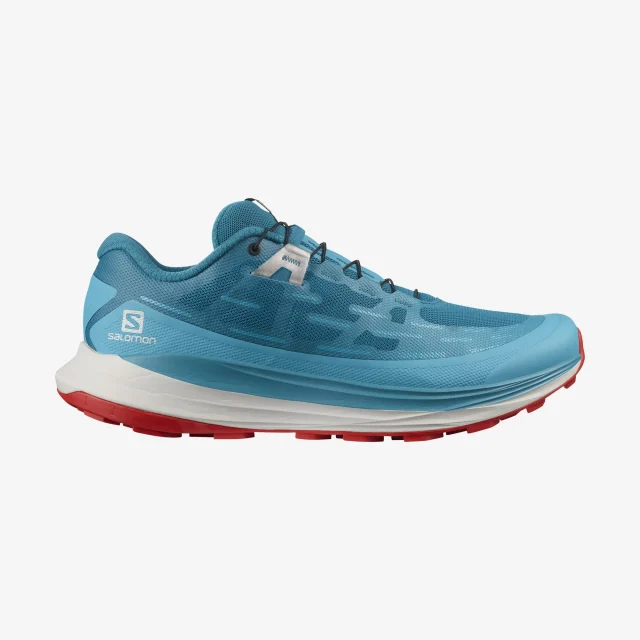
Size Tested: US Men’s 9 and 11.5, respectively
Stated Weight Per Shoe (US Men’s Size 9): 260 g / 9.2 oz
Blister Measured Weight (US Men’s 9):
- Shoes + Laces: 265 g (left) & 261 g (right)
- Insoles: 16 g (left) & 18 g (right)
- Total: 281 g (left) & 279 g (right)
Intro
Salomon’s Ultra Glide, which debuted last year after several Covid-related hangups, arrived as a completely original model from the European brand long heralded for their trail running shoes. After whispers of Salomon finally assenting to demands for a maximally cushioned offering, the Ultra Glide became one of the most anticipated shoes of 2021. Now that the shoe has had a chance to circulate, it’s high time to assess how successfully it answers calls for a more cushioned trail option from Salomon. Gordon Gianniny and I have over 300 miles on the Ultra Glide combined, more than enough to compare notes.
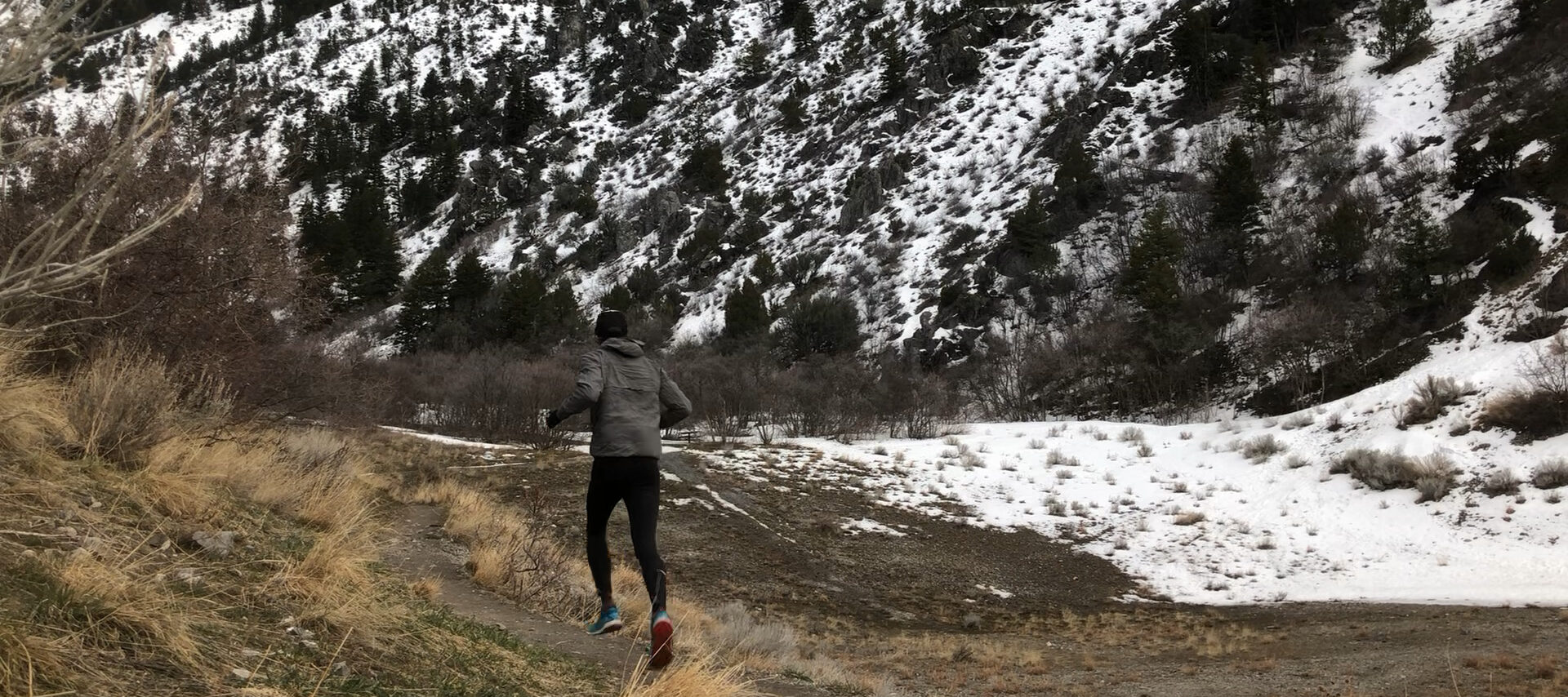
Matt: As a Salomon fan for many years, I’ve seen the brand grow alongside the sport of trail running. It was no surprise to me when, after catching up with our Salomon territory rep during my days working in run specialty shops, he eagerly led me to his Sprinter to show me a pair of unreleased Ultra Glides. Our parking lot tete-a-tete confirmed the inevitable: the polar shift to high-cushioned running shoes had finally forced the hand of the French brand long synonymous with narrow, nimble, and agile footwear. Since receiving my pair, I’ve been loath to run in anything else, which says a lot coming from someone with a picky foot. In this review, Gordon and I will provide a comprehensive breakdown of how we expect the Ultra Glide to relate to most runners.
Gordon: Where to begin? I’ve been curious about the Salomon Ultra Glide pretty much ever since I heard that Salomon was launching a re-vamped, long-distance-specific shoe with lots of cushion in a fairly light package — I’ve been a long-time Salomon fan (mostly for their top-notch uppers — more on that later), but I’ve always felt that their trail shoe lineup was a little lacking on the high-cushion end of things. So when I read the specs for the Ultra Glide for the first time, my interest was definitely piqued. 38 mm of cushion in the heel and 32 in the forefoot? And only 9.2 oz / 260 g? Those numbers fall squarely into the “well cushioned but lightweight” zone that I usually really dig — and when paired with a Salomon upper, I thought that the Ultra Glide had the potential to be an awesome model. After my first 100 miles in the shoe, I think that it’s easily the best high-cushion Salomon shoe I’ve ever tested — and it’s certainly competitive with similar shoes from other brands.
Fit
Matt: Fit is always n-of-1, which sometimes makes it difficult to review. For that reason, I’ll provide a bit of context about my own feet and what I prefer before turning to the Ultra Glide. This reviewer has moderately high arches on feet slightly wider than average. Models with significant support combined with enough room in the forefoot to accommodate toe splay generally work well for me.
When rolling out the Ultra Glide, Salomon repeatedly emphasized width as a design focus, but the shoe doesn’t come across as noticeably wide until you’ve spent some time running in it. Relative to the Salomon S/LAB line, sure, the Ultra Glide feels roomy, but in a wider context (sorry) it’s a far cry from what brands like Altra or Topo offer. That’s largely because Salomon distributes width only where it benefits most feet (i.e., the forefoot tapering to the arch). Reinforced overlays (Sensifit Wings) on either side of the tongue and an aggressive lacing system prevent the shoe’s slightly wider footbed from being too loose-fitting. The balance Salomon strikes between space and security makes the Ultra Glide an accessible model for many kinds of feet, though if your foot carries its width through the arch, I’d make sure to try on a pair in person before buying.
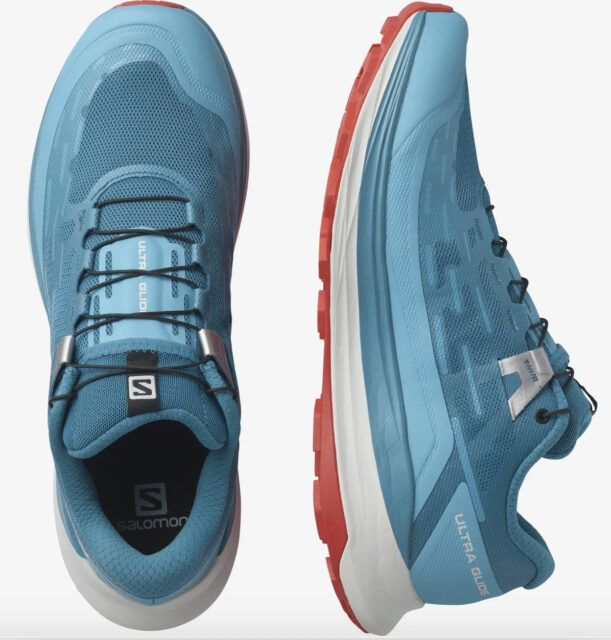
Gordon: I’m pretty much just as stoked on the Ultra Glide’s fit as I have been on the fits of the Sense 4 /Pro, S/Lab Sense Ultra (may it rest in peace), and S/Lab Sense 8. While I won’t get into the technological weeds here (don’t worry, plenty of time for that later), the Ultra Glide’s upper gives the shoe a uniquely secure yet comfortable fit. The heel cup has ample cushioning, but still locks down and holds my heel securely on all types of terrain. The midfoot is similarly secure thanks to the elastic gusseted tongue and midfoot overlays, and the tongue provides plenty of protection from the fairly thin Quicklace system. Finally, while the forefoot isn’t as wide / accommodating as the Altra Timp 2.0 or Topo Mtn Racer 2, it does offer enough space for my fairly narrow feet to spread out a bit — certainly more so than a narrower shoe like the Hoka One One Evo Speedgoat. In total, that makes the Ultra Glide a pretty compelling option for longer runs on all kinds of terrain, at least for my foot shape and fit preferences.
Weight
Matt: Any shoe in the maximal category can expect to have its weight scrutinized. Providing enough cushion and durability is all well and good, but not at the expense of efficiency. Distance running is all about energy conservation and every unneeded gram packed into a shoe is effort wasted. At a stated 9.2 oz (260 g), the Ultra Glide is one of the more efficient examples of trail models with stack heights over 35 mm. Salomon’s ability to push the Ultra Glide under 10 oz while preserving a supple and protective ride shows an awareness for runners taking the shoes deep into ultras, where every stride turns into a negotiation. FWIW, our pair of the size 9 Ultra Glide did come in a bit heavier than the stated weight, at about 280 g per shoe.
A slight knock: I did find the Ultra Glide retains quite a bit of water in wet conditions. The abundance of padding in the heel collar and tongue act as a sponge, effectively sabotaging the model’s weight saving measures when saturated. That being said, unless you live in an area frequently blanketed by rain, it’s a small price to pay for an otherwise impressively light shoe.
Gordon: The Ultra Glide is definitely on the lighter end of the high-cushion trail shoe market — especially when compared to other shoes with 35+ mm stack heights. For reference, here’s how the Ultra Glide (ahem) stacks up to the competition as far as weight goes (all stated weights are based on a US Men’s size 9):
260 g / 9.2 oz — Salomon Ultra Glide
278 g / 9.8 oz — Hoka One One Challenger ATR 6
283 g / 10.0 oz — Topo Athletic Ultraventure 2
306 g / 10.8 oz — Hoka One One Speedgoat 4
306 g / 10.8 oz — ON Running Cloudultra
306 g / 10.8 oz — Brooks Caldera 5
309 g / 10.9 oz — The North Face VECTIV Infinite
320 g / 11.3 oz — Altra Olympus 4.0
329 g / 11.6 oz — adidas TERREX Agravic Ultra
The Ultra Glide feels lighter and more nimble than I would’ve expected for a shoe with a 38 mm / 32 mm stack height, and definitely doesn’t weigh me down on faster-paced runs. I always applaud brands that find ways to reduce weight without sacrificing comfort or performance, and Salomon certainly seems to have found a way to do that here.
Upper
Matt: Gordon has much smarter things to say about the Ultra Glide’s upper than I do so I’ll leave the bulk of the commentary to him. Instead, I’ll focus on an aspect of the shoe that will likely go under appreciated but I think deserves some attention: padding.
The Ultra Glide’s upper is conspicuously padded. It’s one of the first features I noticed after unboxing. Generous amounts of upper material feels like a full embrace of ‘maximal’ design exhibited elsewhere in the shoe. The baggy tongue (where laces are housed when worn) rides up the shin in a way reminiscent of a mid-top basketball shoe. Its outsizedness protects the top of the foot against lacebite, a problem disproportionately affecting Salomon shoes using their Quicklace lacing system (as a longtime sufferer, I really appreciate this consideration).
The Ultra Glide’s heel is also well cushioned, but still rigid enough to prevent slipping or rubbing. Despite logging a ton of steep vertical gain, I never lacked confidence in the security of my heel. Together, the tongue and heel collar highlight the rest of an upper made from pliant, breathable materials that won’t suffocate your feet.
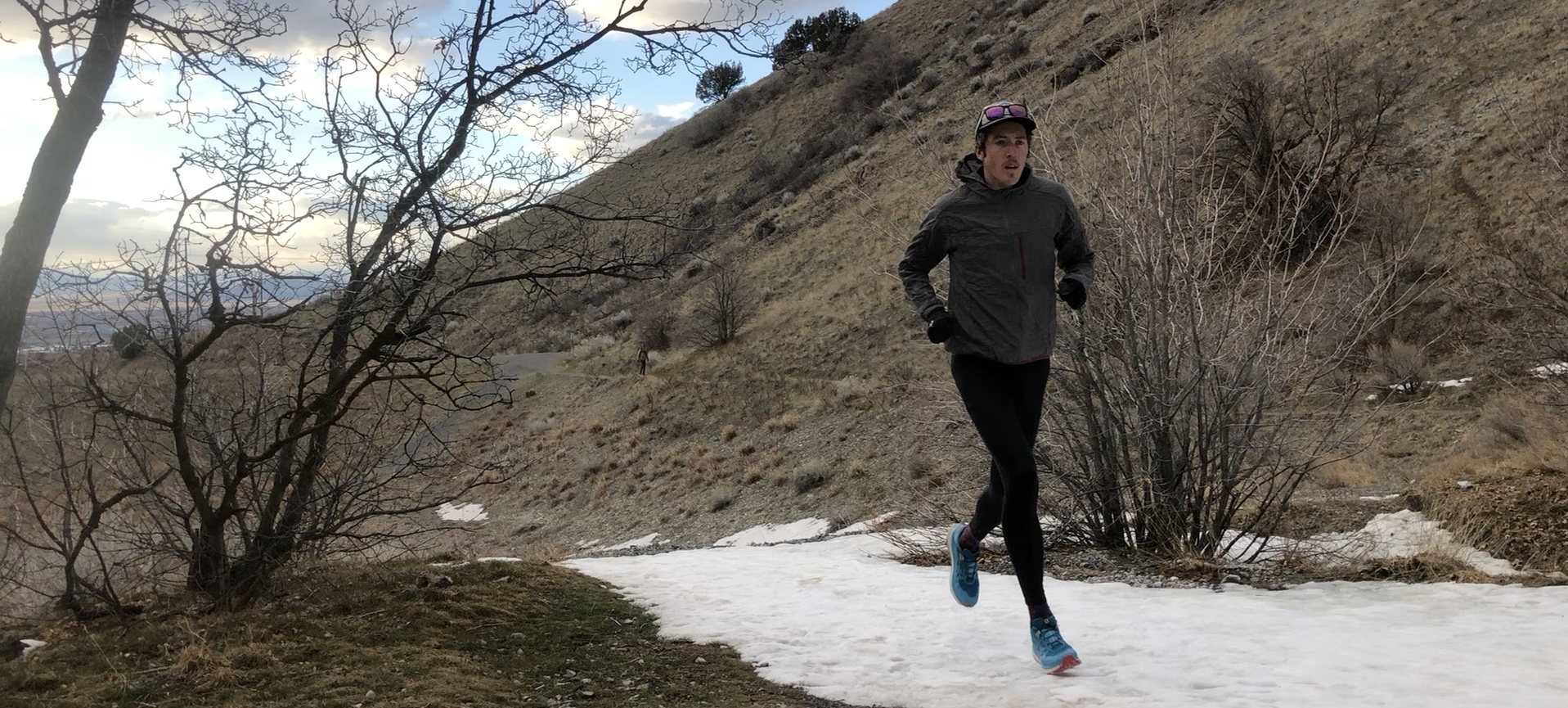
Gordon: Salomon uses three core technologies in most of their trail shoe uppers that, in my opinion, just work better than the uppers on most other shoes. First, the tongue is anchored to the midsole by elastic gussets that run almost the whole length of the tongue. Salomon calls this construction “Endofit,” and it is glorious. Both in the Ultra Glide and in other Salomon shoes, the Endofit bootie holds my midfoot securely in place without being overly tight or constrictive.
Next up, the fairly rigid “Sensifit” overlays, which run from the lacing system down the outside of the upper to the top of the midsole, give the upper a little extra structure, which lends even more security to the fit through the midfoot. The Ultra Glide also has a pair of Sensifit “wings” similar to those found on the S/Lab Ultra 3, which are actually separate from the rest of the upper and connect the top of the lacing system directly to the midsole. These wings provide extra security across the top of my foot and help completely eliminate any side-to-side sliding inside the shoe, even on off-camber terrain. When you pair those three technologies with lightweight, breathable materials and a bit of strategically placed padding, you end up with a pretty darn awesome upper — which is exactly what Salomon has done with the Ultra Glide.
Midsole
Matt: After eclipsing 200 miles, the performance of the Ultra Glide’s midsole is reason enough to invest in a pair. With a stack of 38.2mm / 32.2mm — new heights for Salomon — the Ultra Glide avoids common pitfalls made by brands with similar offerings. Whereas I’ve found most EVA midsoles to be spry and sturdy for their first 50 miles before packing out, the “Energy Surge” foam Salomon uses holds up remarkably well in later miles — the fit of the shoe hasn’t changed. I suspect this has much to do with the midsole construction more so than any single material. The Ultra Glide’s forefoot is reinforced with additional EVA for protection and the shoe’s slight rocker geometry promotes an efficient footstrike.
Now, some of you may have raised an eyebrow at a Salomon shoe, notorious for their narrowness, rocking a 35+ mm stack height. Pairing the two is usually a no-no. Narrow base + high stack = instability. Not so with the Ultra Glide. Salomon designed their shoe in a way that allows the forefoot’s midsole to articulate and bend while the rest of it remains rigid, in effect improving stability by way of improving ground feel. Unlike The North Face Vectiv Enduris, the Hoka One One Stinson ATR 6, or the Altra Olympus 4, shoes that detract from their versatility by dint of their height, the toned-down geometry of the Ultra Glide is steadying, making it ideal for a range of technical trails requiring careful foot placement.
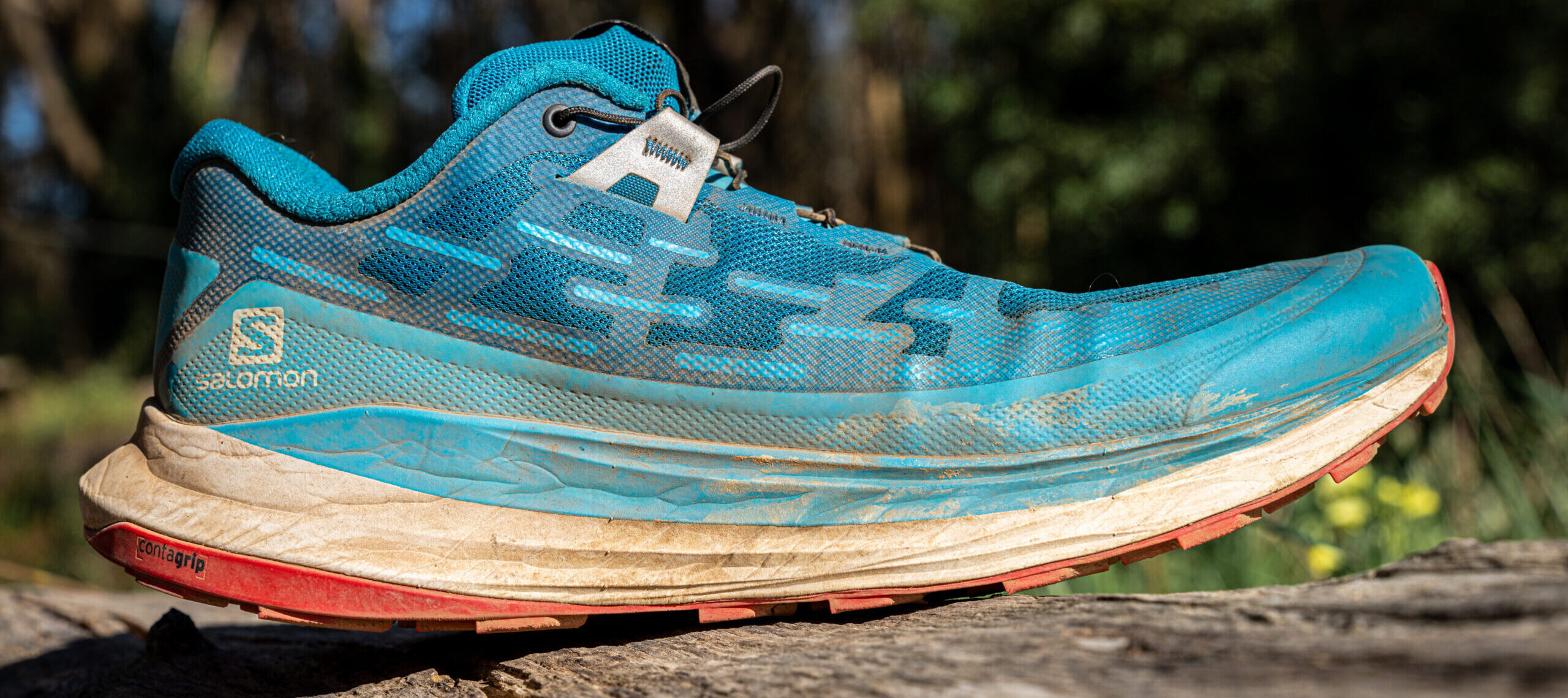
Gordon: While the Ultra Glide’s upper is awesome (in my humble opinion), the shoe’s midsole is what really sets it apart from the rest of Salomon’s line-up. The midsole doesn’t quite rise to the level of the “springy” feel I get from shoes like the Hoka EVO Speedgoat or adidas TERREX Speed Ultra, but it still provides excellent energy return considering how soft it feels underfoot. Unlike other relatively high stack-height Salomon shoes (e.g. Sense Ride or S/Lab Ultra 3), the Ultra Glide truly feels like a plush, max-cushion shoe. At the same time, its relatively light weight and solid energy return keep it from feeling too soft for my preferences.
Outsole
Matt: Salomon did not over-engineer the Ultra Glide’s outsole. If you’ve worn shoes from their trail lineup before — excluding their Speedcross line — the Ultra Glide’s chevron tread will look familiar. Modest 3.5 mm lugs are evenly spaced along the length of the shoe. While I was initially concerned a layout as simple as this would leave the Ultra Glide undergunned on soft terrain, the hardness of the outsole’s Contagrip rubber made up for its lack of lug depth. Without the burden of deeper lugs, the moderately tacky tread is given more surface area to grip the ground and its stiffness maintains that grip over slick surfaces. The decision to go with a moderate outsole also adds to the Ultra Glide’s versatility. Most of my runs include a smattering of concrete, and I found the shoe had no issues transitioning seamlessly from road to trail.
Kudos to Salomon for the restraint showed by not going overboard with their choice of tread. While I’d definitely want a more capable, heavily lugged shoe in technical conditions, the Ultra Glide’s outsole gave me confident footing on every run without being a hindrance when traction was less of a concern.
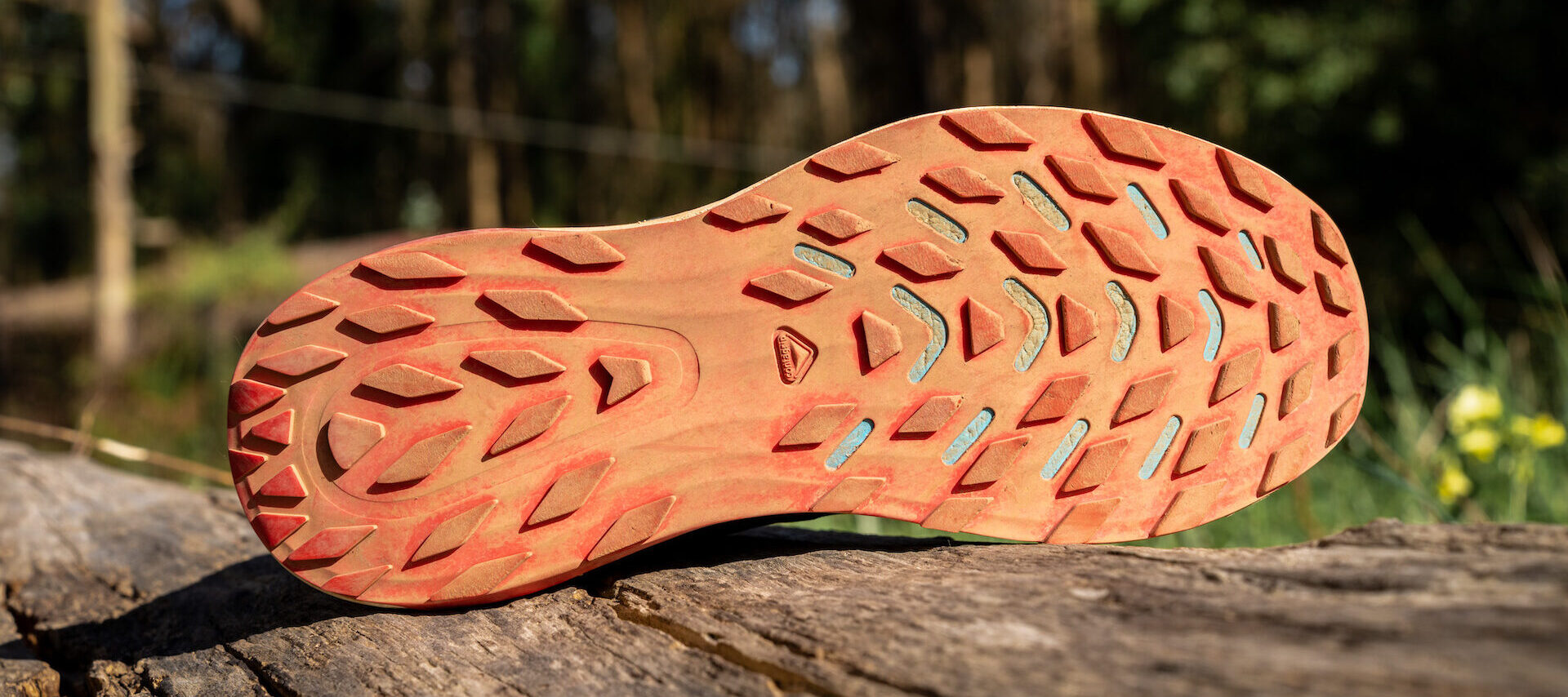
Gordon: I admittedly haven’t had a chance to test the Ultra Glide on a wide variety of snow-free trail surfaces — but I have been impressed with the shoe’s traction on packed snow, loose gravel, and rocky trails. In my opinion, the Ultra Glide’s outsole does exactly what it needs to for the shoe’s intended purpose — the Ultra Glide is designed for long runs on moderate terrain, and its outsole provides plenty of grip for that use case. If you’re tearing up super steep, technical, and/or muddy terrain on the regular, you’d probably be better off with a shoe like the Hoka EVO Jawz or Salomon Speedcross 5 that has bigger / grippier lugs. But otherwise, I think the Ultra Glide’s outsole will provide ample traction.
On Trail
Matt: During my review period I took the Ultra Glide over as diverse an assortment of trails as I could muster. Marin, CA is home to a spectrum of surfaces ranging from compact fire roads to technical singletrack, making it a really well-rounded area for testing shoes. All in all, I’ve put a little over 200 miles on my pair of Ultra Glides, with a long run of 24 miles, and feel like I’ve carved out a nice role for them in my quiver. The shoe performs best on tame trails overlapping with a bit of road, but is far from unpleasant on technical stretches. The longer my runs went, the more appreciative I was to have 38 mm of Energy Surge foam underfoot.
In short, yes, I think Salomon has succeeded in designing a maximal trail shoe for long distances in the Ultra Glide. It’s cushioned yet nimble, lightweight yet protective, roomy yet secure, and perhaps the closest Salomon has come to reproducing (in my opinion) their masterpiece, the S/LAB Sense Ultra. I went through dozens of that model until the day Salomon stopped making it and I’ll likely do the same with the Ultra Glide.
Gordon: As I said above, most of my runs in the Ultra Glide have been on a mix of pavement, snow-packed trails, and the occasional stretch of melted-out trail. I did also get the chance to test the Ultra Glide out on some proper trails in Austin, TX a few weeks ago, but other than that I’ve been a bit limited by terrain for testing.
After about 100 miles in the Ultra Glide, I’ve been impressed pretty much across the board. When you combine the Ultra Glide’s comfortable yet secure upper, light and plush-feeling midsole, and solid traction, you end up with a shoe that’s incredibly versatile. I feel like I could wear the Ultra Glide on full-day mountain runs without getting too much foot fatigue, but it also doesn’t feel out of place at faster paces on mellow trails and roads — which is a pretty rare combination in the trail running shoe space.
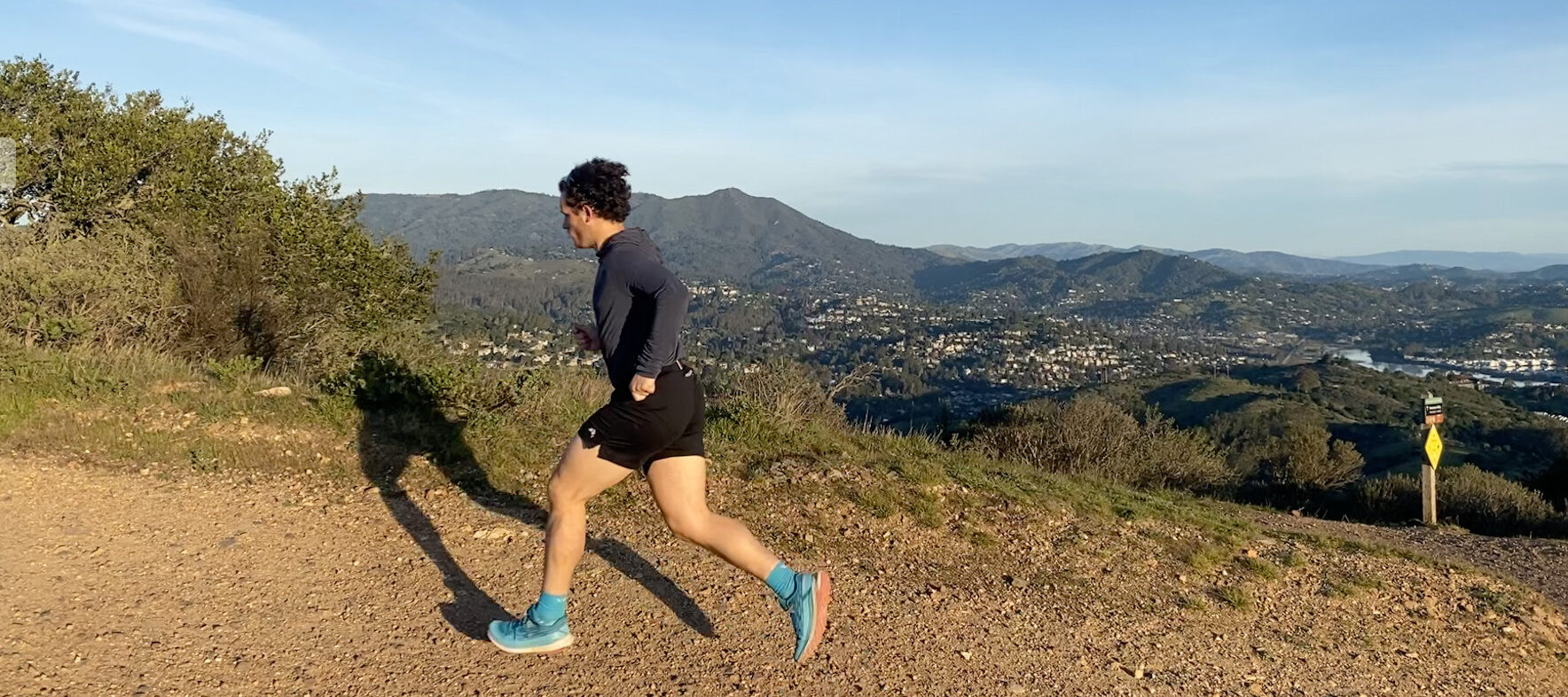
Durability
Matt: As I mentioned earlier, maximal shoes are always laden with concerns about their durability. Using large amounts of foam in the midsole requires that foam to be incredibly lightweight, ergo less resistant to impact. Salomon claims the Ultra Glide should last 500 miles. While I think this is a generous estimation for most runners, I continue to be surprised by how well my pair is holding up, despite how hard I’ve been on them. Common areas of wear (sidewalls, heel collar, toe box) are still unblemished, and the midsole, though not as punchy as it was out of the box, has settled into a comfortable balance between cushion and rebound.
Gordon: After just over 100 miles in the Ultra Glide, I’m not seeing any overly concerning signs of wear. With that said, I’ll have to put more miles on the shoe before I can draw any conclusions about long-term durability. The midsole has a few creases indicating a bit of compaction, but I haven’t noticed any change in the shoe’s ride so far. The outsole looks pretty much the same as it did 100 miles ago, so no complaints there. The upper also seems to be holding up well so far, with one exception — the back of the heel cup is starting to get a little frayed/worn.
Who’s It For?
Matt: Good question! I’d say for the recreational runner not pushing the weekly mileage and who does most of their running on non-technical trails, the Ultra Glide makes an awesome daily trainer. For $140 you’re getting a versatile and durable product that outcompetes many models in its category. Higher-mileage folks can benefit from the shoe during recovery runs or lean on its ample cushioning for longer efforts. It’s likely not the best option for those with very wide feet, though I suspect it is capable of accomodating most foot types.
Gordon: I think Salomon’s Mike Ambrose summed up the Ultra Glide’s intended purpose pretty well on our Off the Couch Podcast a few months ago — it’s the brand’s answer to all the people who say, “Salomon’s great, but their shoes are just too narrow and/or firm for me.”
Whether you’re looking for a lightweight yet cushioned shoe for up-tempo runs on moderate terrain or for a comfortable “all-day” shoe for your next long run / race, I think the Ultra Glide should be on your radar. I wouldn’t necessarily recommend it for true speed work (e.g. intervals on a track) — but that’s also not at all what it’s designed for. Similarly, the Ultra Glide probably wouldn’t be the best choice for extremely steep, technical, and/or muddy terrain. But for most other applications, I think the Ultra Glide’s soft cushioning, accommodating fit, and light weight will work pretty well for a wide variety of folks.
Bottom Line
Matt: Salomon’s reputation as a premier shoemaker in the trail space is in no danger after releasing the Ultra Glide. As latecomers to the maximal shoe explosion, they’ve created a model that circumvents common problems faced by their peers. With few exceptions, runners of all types are getting a versatile, durable, and stable shoe suited for most trails. While use cases will vary based on level of training, the Ultra Glide is well equipped to serve as a daily driver for recreational runners or a long-distance option for more serious athletes.
Gordon: The Salomon Ultra Glide is, in my humble opinion, the best high-cushion shoe Salomon has ever made. I haven’t found many shoes that combine low weight, comfortable cushion, and an excellent fit as well as the Ultra Glide, and so far that combination has kept me coming back to the Ultra Glide for all types of runs. Whether you’re a Salomon diehard looking for a slightly softer option or have previously avoided Salomon’s shoes in favor of brands that offer softer shoes, I think the Ultra Glide is well worth a closer look.


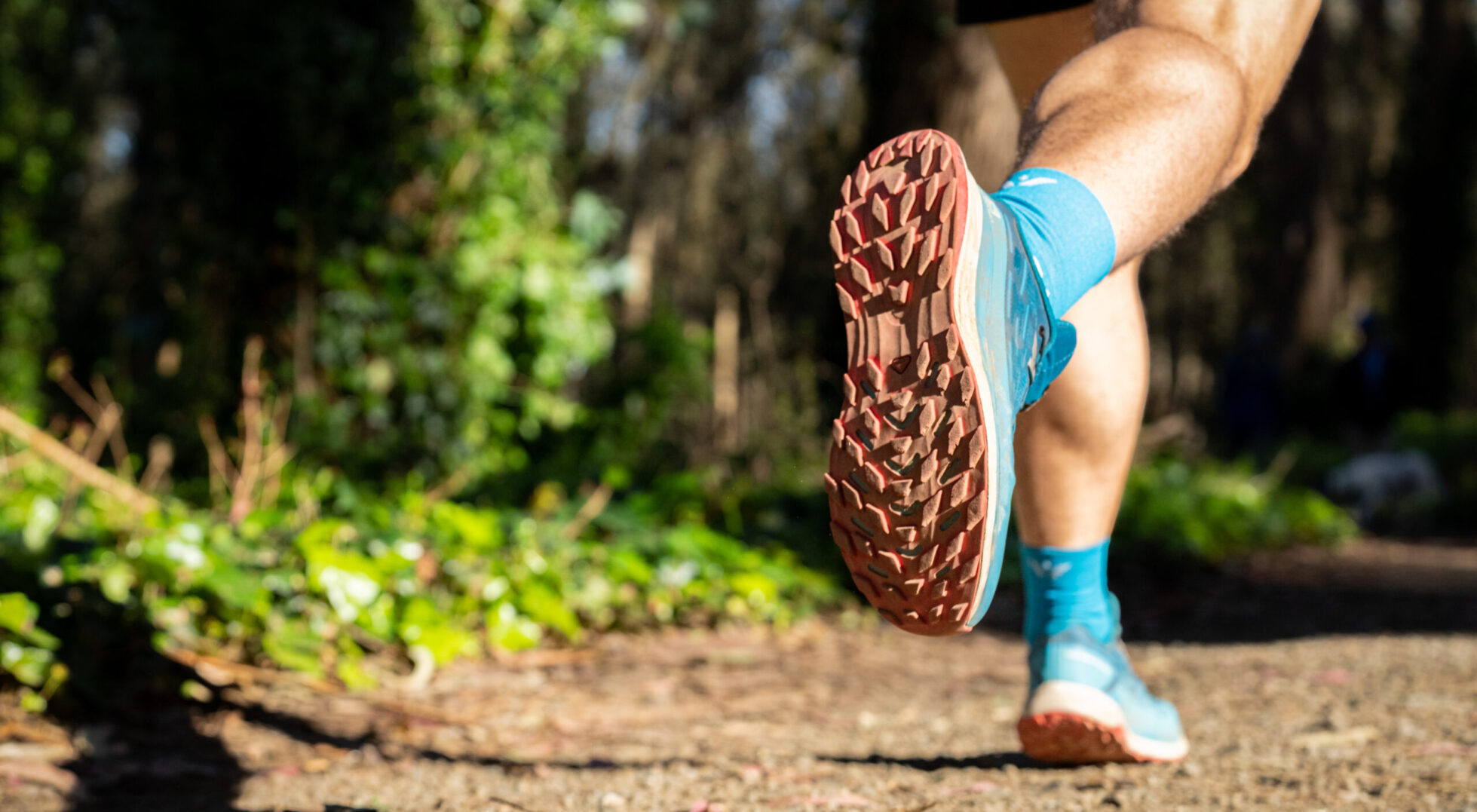

Great review. Long time speed goat fan but live Salomon hiking shoes. I just received my ultra glides yesterday. They feel slightly long. As in a noticeable amount of extra room in front of my toes. Curious if either of you noticed that. Width, foot hold and heel hold all feel awesome. I’m looking forward to my first run.
Hey Quenten,
I’ve found most Salomon trail running models run a smidge long, so I’ll generally go down half a size from what I customarily wear in other brands. That’s definitely not specific to the Ultra Glide. However, if width and fit are a nonissue then I wouldn’t be too concerned about having extra room in the forefoot, your toenails will probably appreciate it! Thanks for reading.